
Coffee grounds are a daily occurrence in many households and are an ideal fertilizer for tomatoes. With the right use, you can increase the yield and promote the health of the tomato plants.
In a nutshell
- contains ingredients that promote growth and fruiting
- Only use coffee grounds in dried form
- Suitable as a long-term fertilizer in solid form or as a liquid fertilizer
- fertilize with coffee grounds every four weeks on average
- suitable for all tomato types
Table of contents
- ingredients
- Prepare coffee grounds
- Application
- fertilizer frequency
- frequently asked Questions
ingredients
coffee grounds contains a number of ingredients that tomatoes as heavy feeder prefer. Coffee grounds are an ideal fertilizer, especially during fruit formation.
Ingredients and their effect:
- Nitrogen promotes shoot formation and leaf growth
- potassium increases the resistance of the plants
- Phosphorus supports photosynthesis and promotes the formation of flowers, fruits and root growth
- Magnesium supports photosynthesis and is required for the formation of chlorophyll
- Sulfur supports the absorption of potassium and has a positive effect on the taste
- Antioxidants promote resistance

The coffee grounds also has a positive effect on the soil structure. The soil can absorb more water, which means you have to water the plants less.
Notice: The coffee grounds can den soil pH lower, which is why you should check it regularly. So that the soil does not become too acidic, you can spread lime, which can increase the pH again.
Prepare coffee grounds
Suitable for fertilizing coffee grounds from ground beans. It doesn't matter whether it was previously in coffee pads or whether you use filter coffee. In order for your plants to get the greatest possible benefit from the coffee grounds, you need to prepare them appropriately.
A common mistake is not drying the coffee grounds quickly and completely. This leads to mold growth. The Mold can harm the plants, which is why it is important that you dry the coffee grounds as quickly as possible.
How to properly dry coffee grounds:
- Separate the coffee grounds from the filter or pad
- coarsely crumble
- spread on a baking sheet
- either in the oven or on a warm or dry sunny place

Tip: To save energy, you can use the waste heat from the oven, for example. In winter, there is a place on the heater to dry.
After the coffee grounds are completely dry, crumble them up with your fingers or in a mortar. The finer the powder, the faster the ingredients are dissolved and are available to the tomato plants.
Application
You can use the coffee grounds either as a liquid fertilizer or as a long-term fertilizer in solid form.
Fertilizing with ground coffee:
- Spread coffee grounds around the tomato plant
- incorporate carefully
- pour
Production of liquid fertilizer:
- Fill the watering can with water
- Add ground coffee
- stir
- Leave for 6-12 hours

Regardless of whether you want to use the ground coffee as a long-term fertilizer or as a liquid fertilizer, you need 50 g of ground coffee per plant. You can use a little more ground coffee for salad and beefsteak tomatoes, as they have a higher nutrient requirement than cocktail tomatoes.
Notice: In principle, you can use coffee grounds as fertilizer for all types of tomatoes. Only for seedlings or The fertilizer is not suitable for very young plants as it is too rich.
fertilizer frequency
On average, tomato plants are fertilized with the coffee grounds every four weeks. During fruiting, you can reduce the frequency to three weeks.

With freshly planted tomatoes, you should wait four weeks before using them for the first time Fertilize coffee grounds, since the substrate is usually rich in nutrients. You can already incorporate a small amount into the substrate for planting.
frequently asked Questions
Basically, there is no fertilizer that would not be suitable for tomatoes. It is important that you provide the plants with a balanced mix of nutrients. For example, only giving the plants nitrogen would result in rapid growth. In return, the formation of flowers falls by the wayside and the plants become more susceptible to diseases.
Due to the high nitrogen content, the coffee grounds are not suitable for herbs. In addition, various ornamental plants, such as asters or boxwood, do not like the coffee grounds. When it comes to vegetables, onions and carrots don’t appreciate the ground coffee.
It is best to store dried coffee grounds in a tight container so that they are protected from moisture. It can then be stored indefinitely. You can store fresh coffee grounds that are still damp in a container for a maximum of one to two days. If the coffee grounds remain damp for too long, they can start to get mouldy.
Theoretically, unbrewed coffee beans can also be used for fertilization. However, the fresh bean flour is very rich in content, which is why the risk of over-fertilization is high.



